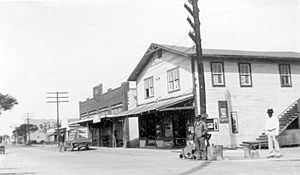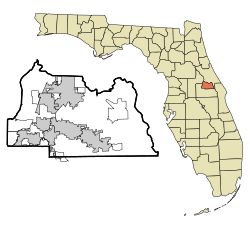Goldsboro, Florida facts for kids
Quick facts for kids
Goldsboro
Goldsborough
|
|
|---|---|
|
Town
|
|

Goldsborough c.1920
|
|
| Country | |
| State | |
| County | Seminole |
| Incorporated | December 1, 1891 |
| Dissolved | April 26, 1911 |
| Founded by | William Clark |
| Area
|
|
| • Total | 1.018 sq mi (2.64 km2) |
| Elevation | 35 ft (10.7 m) |
| Population | |
| • Total | 2,537 |
| • Density | 2,751/sq mi (1,062/km2) |
| Time zone | UTC-5 (Eastern (EST)) |
| • Summer (DST) | UTC-4 (EDT) |
| ZIP code |
32772
|
| Area code(s) | 321/407 |
Goldsboro is a historic community in Seminole County, Florida. It was one of the first towns in the United States founded by African Americans after the American Civil War. It was officially started by the Freedmen's Bureau and became an independent town in 1891. Goldsboro was known for being a place where African Americans could build their own community. However, in 1911, it became part of the nearby city of Sanford, Florida.
Contents
A Look Back at Goldsboro's History
Goldsboro was created during a time called the Reconstruction Era (after the Civil War). The Freedmen's Bureau helped establish it for African Americans. Many residents worked in local railroad yards, on farms, or in ice houses.
In 1891, the people of Goldsboro decided to make their community an official town. They announced their plans in the Sanford Journal newspaper. On December 1, 1891, Goldsboro officially became a town. William Clark, a local merchant, and 19 African American voters helped make this happen. Walter Williams was Goldsboro's first mayor, serving until 1892.
In 1900, Goldsboro had a population of 71 people. By 1905, it had grown to 100 residents. Morris Benjamin Bellamy Sr. was the mayor of Goldsboro in 1911.
Goldsboro Joins Sanford
In 1911, a nearby community called Sanford Heights decided to separate from Sanford. This happened because they were not happy with the services Sanford was providing. This made people in Sanford worried that their city could not grow. Goldsboro, Georgetown, and Sanford Heights surrounded Sanford, along with Lake Monroe to the north.
Forrest Lake, a state representative and former mayor of Sanford, worked to make Sanford bigger. He wanted to prevent Sanford Heights from becoming independent. Goldsboro was also a target in his plan to expand Sanford. Goldsboro's leaders wrote letters to local newspapers to protest this.
On April 6, 1911, the Sanford city council voted to include Goldsboro within its boundaries. Then, on April 26, 1911, the Florida legislature passed a new law called the Sanford Charter Bill. This law officially ended Goldsboro's status as an independent town. It also reorganized Sanford as a larger city that now included Goldsboro.
After Goldsboro lost its independent status, its unique identity slowly faded. Sanford even changed the names of some of Goldsboro's historic streets. Clark Street, named after the town's founder, William Clark, was renamed Lake Street. This new name honored Forrest Lake, the person who helped Goldsboro lose its town status.
Recent Developments in Goldsboro
In 2007, plans were made to build a Public Safety Complex in Goldsboro. This was part of Sanford's efforts to improve the area. By November 2010, the Sanford Police Department moved into the new complex. This large building is shared with the Sanford Fire Department.
A historical museum opened in Goldsboro in 2011. It is located at the site of the original post office. The museum displays old photographs, historical documents, and furniture. These items were donated by local residents.
On February 28, 2013, Lake Avenue was renamed William Clark Avenue. This change honored William Clark, the founding father of Goldsboro.
Population Changes Over Time
| Historical population | |||
|---|---|---|---|
| Census | Pop. | %± | |
| 1900 | 71 | — | |
| 1910 | 286 | 302.8% | |
| U.S. Decennial Census | |||


